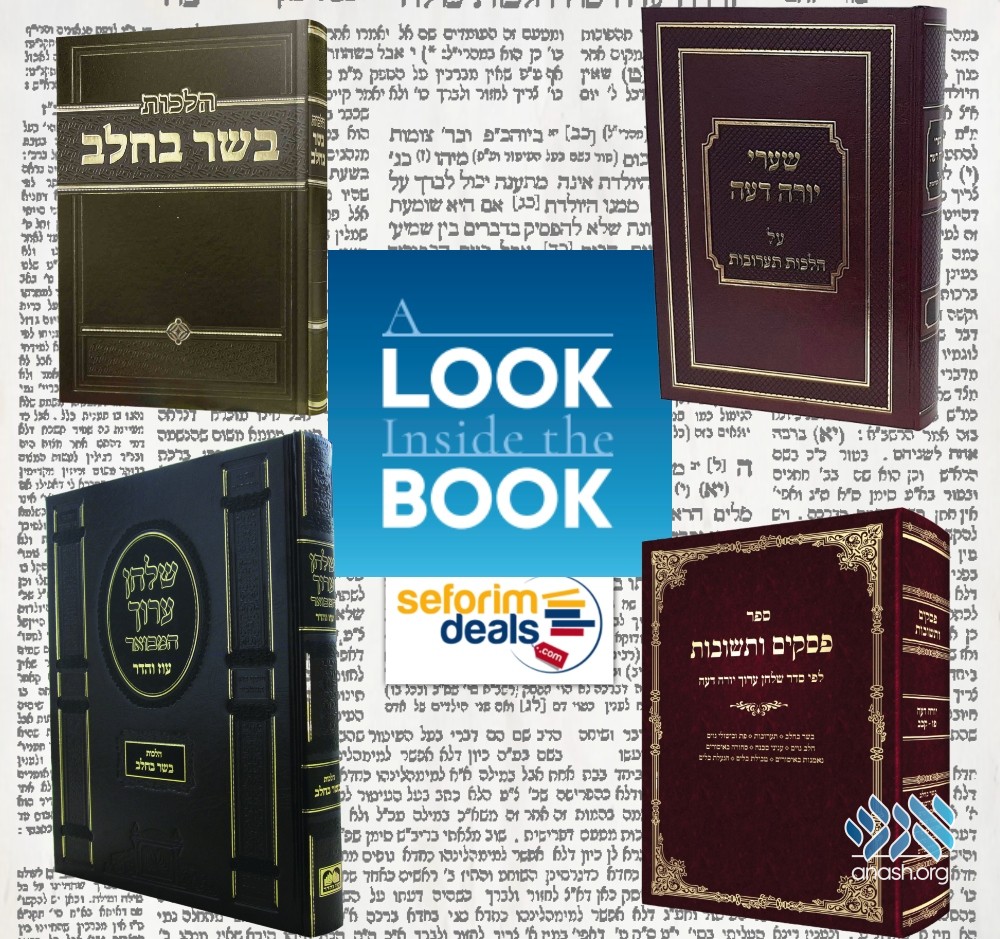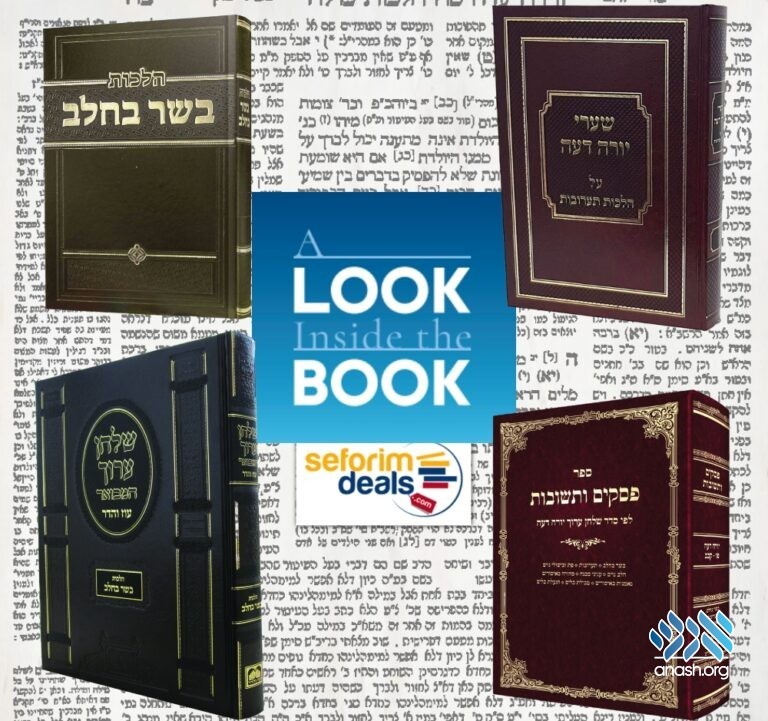כ״ה אלול ה׳תשפ״א | September 1, 2021
The Seforim That Will Enhance Your Semicha Studies
A Look Inside the Book: As the new yeshiva year begins, many bochurim also began Hilchos Issur V’Heter (“Semicha”). This article will survey a number of seforim that are helpful for this important study.

A Look Inside the Book: As the new yeshiva year begins, many bochurim also began Hilchos Issur V’Heter (“Semicha”). This article will survey a number of seforim that are helpful for this important study.
By Shmuel Super
In this article, we will survey a number of seforim on the halachos from Yoreh Deah that are studied for semichah. We will begin with aids to the study of the Shulchan Aruch and its nosei keilim, and then examine some practical halachah seforim that focus on the contemporary application of these halachos in the modern kitchen.
Shulchan Aruch Hamevuar – Basar Bechalav
Oz Vehadar, 5771
The Oz Vehadar Shulchan Aruch Hamevuar on Hilchos Basar Bechalav is comprised of five sections. As an introduction to the topic, the sefer begins with encyclopedia-style brief summaries of key concepts in Hilchos Basar Bechalav and Taaruvos, such as ביטול, חתיכה נעשית נבילה and נ”ט בר נ”ט.
The summaries provide a basic definition of the concept, trace it through the sources in the Gemara, explain the deoraysa and derabanan levels when applicable, and provide basic details regarding how the concept is applied. These summaries are excellent to read as an introduction before beginning to learn the halachos, and to consult when the concept arises in the course of study.
The second section of this sefer is an elucidated Shulchan Aruch, following the same general format as the popular Mesivta Gemaras.
The right hand page presents a traditional tzuras hadaf style format of the text of the Shulchan Aruch, surrounded by the Shach and Taz, and the Biur Hagra, Chidushei R. Akivah Eiger, Be’er Heitev, and Pischei Teshuvah beneath.
The facing page on the left contains an elucidation of the text of the Shulchan Aruch. Every siman begins with an introduction surveying the content of the siman and providing background information for the key concepts it discusses. This is a very helpful feature, but the introductions are somewhat lengthy, and sometimes include chakiros that aren’t necessary as an introduction.
Each se’if is given a header describing its contents and the more complex se’ifim have their own introduction providing background about the various opinions in the rishonim, clarifying concepts that will be introduced, and summarizing the se’if. This is followed by the text of the se’if with an interpolated explanation of the mechaber and the Rema, copiously footnoted with sources and additional comments.
These very helpful introductions could have perhaps been improved if the summary parts had been separated from the introduction and instead placed at the end of the se’if as a chazarah aid.
The third section of this volume is the explanations of the Shach and Taz. This section includes the original text of every se’if katan, alongside a biur that is essentially a rewording of the content of the seif katan—including all of the shakla vetarya—in a simpler style that is easier for non-experienced students to follow. The footnotes summarize the chidushei dinim of the se’if katan and cite the opinions of the later achronim on the matter, including the key pieces from Peri Megadim.
The fourth section is titled תוספות ההלכה ואוצר השו”ת, and it contains a lengthy and detailed analysis of practical halachic questions, arranged in the order of the simanim of the Shulchan Aruch. These pieces trace the halachah from the original sources down to its contemporary application in sifrei shu”t.
The fifth and final section, תמצית הסימנים , presents brief se’if-by-se’if summaries of the key points from each of the previous three sections. This is a very useful aid for chazarah.
Shulchan Aruch Hamevuar is an excellent volume that all semichah students will benefit from greatly, even if they don’t need every one of the many elements and lengthy explanations this sefer contains.
Shulchan Aruch Hamevuar can be purchased here.
***
Shaarei Yoreh Deah – Melichah, Basar Bechalav, and Taaruvos
Rabbi Eliezer Brod, 5762-5781
Rabbi Eliezer Brod’s recently published Shaarei Yoreh Deah on Hilchos Taaruvos (5781) joins the previous volumes on Hilchos Basar Bechalav (5762) and Hilchos Melichah (5769), thus completing a set covering the three sections of Yoreh Deah studied for semichah.
Shaarei Yoreh Deah reproduces the original text of the Shulchan Aruch at the top of the page. Beneath this appears Nesiv Hashach and Nesiv Hataz, which contain brief summaries of the Shach and Taz.
Finally, at the bottom of the page there are footnotes titled Harchev Davar which expand the discussion beyond the words of the Shulchan Aruch and its basic nosei keilim. This section quotes additional details regarding the halachos from other poskim, provides further explanation of the difficult pieces in the Shach and Taz, and also indicates what the practical halachah is in cases of machlokes between the aforementioned authorities.
An additional important feature of the Harchev Davar is the citation of the opinions of the Alter Rebbe and Tzemach Tzedek. We do not possess the parts of the Alter Rebbe’s Shulchan Aruch on these halachos, but there are related discussions of many of these sugyos in other places in the Alter Rebbe’s Shulchan Aruch, such as Hilchos Pesach. The Tzemach Tzedek also gives some rulings regarding these halachos in various places.
Due to this information being scattered across various seforim, insufficient attention was paid to it in the past. Piskei Admur Hazaken Behilchos Isur Veheter, published by Kehos (5756) collected all of the relevant material from the seforim of the Alter Rebbe and Tzemach Tzedek, and Shaarei Yoreh Deah incorporates this information in the Harchev Davar.
The volume on Melichah also includes rulings from the She’eiris Yehudah, by the Alter Rebbe’s brother, Harav Yehudah Leib of Yanovitch.
Harchev Davar also addresses some practical questions, quoting from contemporary poskim, but far from enough to teach the student how to apply these halachos in a modern kitchen.
The volume on Hilchos Basar Bechalav also contained some lengthier excursuses at the end of the volume under the title Iyun Davar, but in the other volumes such information was incorporated into the Harchev Davar as well.
The author of these seforim, Rabbi Eliezer Brod, has many years of experience in teaching bochurim for semichah in Yeshivas Ohr Simchah in Kfar Chabad. This experience shows in the seforim, which are clear and concise, providing the information necessary for a basic grasp on the halachos.
Shaarei Yoreh Deah – Hilchos Taaruvos can be purchased here.
Shaarei Yoreh Deah – Hilchos Basar Bechalav can be purchased here.
Shaarei Yoreh Deah – Hilchos Melichah can be purchased here.
***
Pesakim Uteshuvos – Yoreh Deah 87-122
Rabbi Aharon Aryeh Katz, 5781
The new Pesakim Uteshuvos on Yoreh Deah 87-122, by Rabbi Aharon Aryeh Katz, follows the format of the acclaimed Piskei Teshuvos on Orach Chayim, which was written by Rabbi Katz’s father-in-law, Rabbi Simchah Rabinowitz. A previous volume in this series published in 5777 covered simanim 240-266 of Yoreh Deah, and a revised edition of this volume is forthcoming.
The new volume covers the halachos of Basar Bechalav and Taaruvos; the rules of sfek sfeika (double doubt) and its application in paskening halachah; maachalei akum; and tevilah and hagalas keilim.
This sefer helps address an unfortunate problem with the way Yoreh Deah is often learned. There is a wide chasm between the reality of kitchens in the time of the Shulchan Aruch and nosei keilim and our own modern reality. It is therefore possible for a bochur to learn all of the halachos thoroughly, pass the tests, and receive semichah, and yet still be almost clueless when confronted with a practical question in the kitchen.
Pesakim Uteshuvos bridges this gap between the classic halachic sources and the contemporary kitchen. Following the order of the Shulchan Aruch, Pesakim Uteshuvos addresses the related practical halachic questions, with an emphasis on the modern questions that result from technological development. Every se’if starts with the relevant piece from Shulchan Aruch, and goes through the opinions of later poskim, up to the contemporary authorities who apply the halachos to our modern reality.
For example, Pesakim Uteshuvos addresses the contemporary questions of cooking meat and dairy together in ovens with broil setting, toaster ovens, pyrolytic self-cleaning ovens, double ovens with separate compartments, and microwaves. Practical instructions are also given for kashering modern ovens and microwaves (92:23-26). Practical questions such as what to do if a hot fleishig lid was placed on a milchig counter are also addressed (93:7).
This volume contains a detailed index, and also a new feature—biographical information for seforim quoted to help the reader assess their place in the halachic process. There is a list of Hebrew terms in the back of the book with English translations, but these are mainly for foods and ingredients, omitting many important technical terms. For example, the oven setting known in modern Hebrew as גריל is called “broil” in English, and תנור פירוליטי means a pyrolytic self-cleaning oven. Translations of these technical terms are missing, and this will challenge the non-Israeli reader at times.
Pesakim Uteshuvos is an ideal companion volume to be studied alongside the simanim in the Shulchan Aruch. As mentioned above, the Shulchan Aruch Hamevuar also contains a section dedicated to practical questions, but Pesakim Uteshuvos is more concise and comprehensive.
Beyond its value for those learning for semichah, Pesakim Uteshuvos is an important sefer for every Jewish home with a kitchen. While the author makes clear that such works of likutim shouldn’t be relied upon without looking up the sources and consulting a Rov when necessary, many simple questions that arise can be resolved by looking up the topic in this sefer, and for more complex matters one will learn how to pose the question to a Rov.
Pesakim Uteshuvos can be purchased here.
***
Hilchos Basar Bechalav
Rabbi Zeev Hofstedter, 5780
Hilchos Basar Bechalav is another practical halachah sefer, authored by Rabbi Zeev Hofstedter.
This sefer follows its own independent structure, rather than the order of the Shulchan Aruch, and contains 14 chapters on general Basar Bechalav topics, such as כללי דיני כלי שאינו בן יומו, טעות בכלים בשריים וחלביים, דרגות החום. The topic selection and order here are designed for practicality, not abstract analysis of the underlying sugyos.
Each chapter is divided into a number of subsections and numerous se’ifim. The main text states concise practical halachos, and the copious footnotes source and expound on them. For example, Chapter 5, titled דרגות החום, goes through all the dinim of כלי ראשון and the different forms of עירוי from it, the dinim of כלי שני, and then details about washing dishes in kitchen sinks, kashering, dishwashers, and halachos pertaining to countertops.
The volume contains detailed indexes, and provides /English translations for modern Hebrew terms in brackets, as they come up.
The structure of this book makes it best suited for use as a general summary and practical application of the halachos for those learning for semichah.
Hilchos Basar Bechalav can be purchased here.
***
‘A Look Inside the Book’ is a bi-weekly feature on Anash.org, taking a look at what’s new in the shelves of Seforim stores.


check out this sefer too!
https://www.lulu.com/en/us/shop/schneur-glaser/%D7%9E%D7%A8%D7%90%D7%94-%D7%9E%D7%A7%D7%95%D7%9E%D7%95%D7%AA-%D7%A2%D7%9C-%D7%94%D7%9C%D7%9B%D7%95%D7%AA-%D7%90%D7%99%D7%A1%D7%95%D7%A8-%D7%95%D7%94%D7%99%D7%AA%D7%A8/paperback/product-12q692gg.html?page=1&pageSize=4